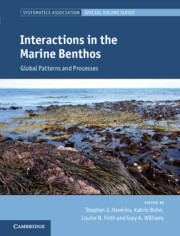Book contents
- Interactions in the Marine Benthos
- The Systematics Association Special Volume Series
- Interactions in the Marine Benthos
- Copyright page
- Contents
- Preface
- Contributors
- Chapter 1 Introduction
- Chapter 2 The Intertidal Zone of the North-East Atlantic Region
- Chapter 3 The Ecology of Rocky Subtidal Habitats of the North-East Atlantic
- Chapter 4 Rocky Intertidal Shores of the North-West Atlantic Ocean
- Chapter 5 Subtidal Rocky Shores of the North-West Atlantic Ocean
- Chapter 6 Shallow Water Muddy Sands of the North-West Atlantic Ocean
- Chapter 7 Biodiversity and Interactions on the Intertidal Rocky Shores of Argentina (South-West Atlantic)
- Chapter 8 Species Interactions and Regime Shifts in Intertidal and Subtidal Rocky Reefs of the Mediterranean Sea
- Chapter 9 The Restructuring of Levant Reefs by Aliens, Ocean Warming and Overfishing
- Chapter 10 North-East Pacific
- Chapter 11 The North-East Pacific
- Chapter 12 Consumer–Resource Interactions on an Environmental Mosaic
- Chapter 13 Where Three Oceans Meet
- Chapter 14 Rocky Shores of Mainland China, Taiwan and Hong Kong
- Chapter 15 Biogeographic Comparisons of Pattern and Process on Intertidal Rocky Reefs of New Zealand and South-Eastern Australia
- Chapter 16 The Past and Future Ecologies of Australasian Kelp Forests
- Chapter 17 Kropotkin’s Garden
- Chapter 18 Biofilms in Intertidal Habitats
- Chapter 19 Interactions in the Deep Sea
- Chapter 20 Overview and Synthesis
- Index
- Systematics Association Special Volumes
- References
Chapter 12 - Consumer–Resource Interactions on an Environmental Mosaic
The Role of Top-Down and Bottom-Up Forcing of Ecological Interactions along the Rocky Shores of the Temperate South-Eastern Pacific
Published online by Cambridge University Press: 07 September 2019
- Interactions in the Marine Benthos
- The Systematics Association Special Volume Series
- Interactions in the Marine Benthos
- Copyright page
- Contents
- Preface
- Contributors
- Chapter 1 Introduction
- Chapter 2 The Intertidal Zone of the North-East Atlantic Region
- Chapter 3 The Ecology of Rocky Subtidal Habitats of the North-East Atlantic
- Chapter 4 Rocky Intertidal Shores of the North-West Atlantic Ocean
- Chapter 5 Subtidal Rocky Shores of the North-West Atlantic Ocean
- Chapter 6 Shallow Water Muddy Sands of the North-West Atlantic Ocean
- Chapter 7 Biodiversity and Interactions on the Intertidal Rocky Shores of Argentina (South-West Atlantic)
- Chapter 8 Species Interactions and Regime Shifts in Intertidal and Subtidal Rocky Reefs of the Mediterranean Sea
- Chapter 9 The Restructuring of Levant Reefs by Aliens, Ocean Warming and Overfishing
- Chapter 10 North-East Pacific
- Chapter 11 The North-East Pacific
- Chapter 12 Consumer–Resource Interactions on an Environmental Mosaic
- Chapter 13 Where Three Oceans Meet
- Chapter 14 Rocky Shores of Mainland China, Taiwan and Hong Kong
- Chapter 15 Biogeographic Comparisons of Pattern and Process on Intertidal Rocky Reefs of New Zealand and South-Eastern Australia
- Chapter 16 The Past and Future Ecologies of Australasian Kelp Forests
- Chapter 17 Kropotkin’s Garden
- Chapter 18 Biofilms in Intertidal Habitats
- Chapter 19 Interactions in the Deep Sea
- Chapter 20 Overview and Synthesis
- Index
- Systematics Association Special Volumes
- References
Summary
Biogeography, phylogeography and ecology of the diverse assemblage that inhabits the south-east Pacific along the Humboldt Current system (HCS) has received increasing attention. Regions separated by biogeographic break evidence changes in the functional structure of consumer assemblages, likely related to a replacement from tropical to temperate species. The deep temporal signature of coastal oceanography on coastal biogeography and phylogeography is underpinned by the spatial structure of bottom-up effects of ecological processes, which also influence the strong top-down regulation of consumers on the structure of rocky shore communities. Uncertainties still remain about how coastal oceanographic processes regulate species range expansion/contraction and how biotic interactions and environmental filtering define dynamic biogeographic patterns along marine environments. Explicit predictions should be made regarding the persistence and dynamics of species ranges, and changing ecological interactions among species in the face of intensified human harvesting (e.g., kelps) and global change. Clear cooling trends are observed across the HCS, human harvesting is intensifying and presence of coastal artificial infrastructure could trigger species range shift. Aquaculture expansion and the introduction of exotic non-native species have the potential to alter community structure and functioning. Hence, ecosystem services should be managed, and necessary interventions carefully planned to ensure sustainability of use of natural marine resources and coastal ecosystem integrity.
Keywords
- Type
- Chapter
- Information
- Interactions in the Marine BenthosGlobal Patterns and Processes, pp. 307 - 332Publisher: Cambridge University PressPrint publication year: 2019
References
- 5
- Cited by

